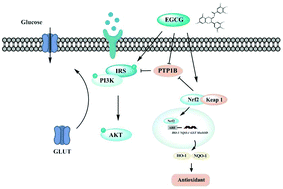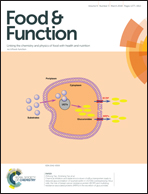EGCG evokes Nrf2 nuclear translocation and dampens PTP1B expression to ameliorate metabolic misalignment under insulin resistance condition†
Abstract
As a major nutraceutical component of green tea (−)-epigallocatechin-3-gallate (EGCG) has attracted interest from scientists due to its well-documented antioxidant and antiobesity bioactivities. In the current study, we aimed to investigate the protective effect of EGCG on metabolic misalignment and in balancing the redox status in mice liver and HepG2 cells under insulin resistance condition. Our results indicated that EGCG accelerates the glucose uptake and evokes IRS-1/Akt/GLUT2 signaling pathway via dampening the expression of protein tyrosine phosphatase 1B (PTP1B). Consistently, ectopic expression of PTP1B by Ad-PTP1B substantially impaired EGCG-elicited IRS-1/Akt/GLUT2 signaling pathway. Moreover, EGCG co-treatment stimulated nuclear translocation of Nrf2 by provoking P13K/AKT signaling pathway and thus modulated the downstream expressions of antioxidant enzymes such as HO-1 and NQO-1 in HepG2 cells. Furthermore, knockdown Nrf2 by small interfering RNA (siRNA) notably enhanced the expression of PTP1B and blunt EGCG-stimulated glucose uptake. Consistent with these results, in vivo study revealed that EGCG supplement significantly ameliorated high-fat and high-fructose diet (HFFD)-triggered insulin resistance and oxidative stress by up-regulating the IRS-1/AKT and Keap1/Nrf2 transcriptional pathways. Administration of an appropriate chemopreventive agent, such as EGCG, could potentially serve as an additional therapeutic intervention in the arsenal against obesity.



 Please wait while we load your content...
Please wait while we load your content...